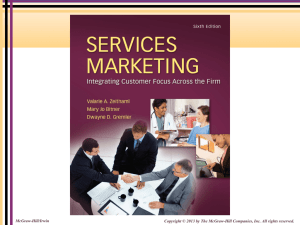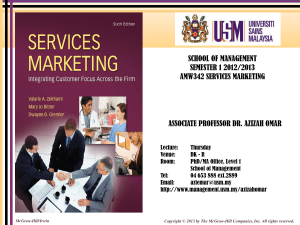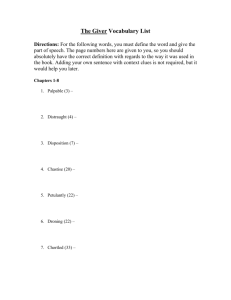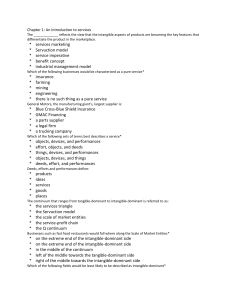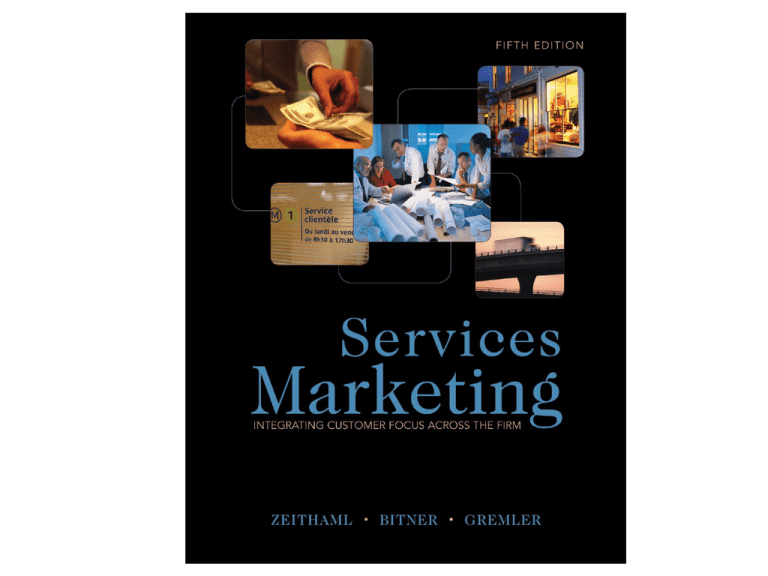
A Note on the
PowerPoint Slides...
1-2
These PowerPoint slides contain selected exhibits,
figures, and tables from the chapters as well as
objectives for the chapters. For some chapters,
we include extra lecture slides and in-class
exercises that we have compiled and used in our
classes. The lecture slides are not intended to
provide full outlines or complete lectures for the
chapters, but rather may be used selectively to
enhance class sessions.
1-3
Part 1
FOUNDATIONS
FOR SERVICES
MARKETING
Chapter1-4
Introduction to Services
1
What are services?
Why services marketing?
Service and Technology
Characteristics of Services Compared to Goods
Services Marketing Mix
Staying Focused on the Customer
McGraw-Hill/Irwin
Copyright © 2009 by The McGraw-Hill Companies, Inc. All rights reserved.
Objectives for Chapter 1:
Introduction to Services
Explain what services are and identify important trends in services.
Explain the need for special services marketing concepts and
practices and why the need has developed and is accelerating.
Explore the profound impact of technology on service.
Outline the basic differences between goods and services and the
resulting challenges and opportunities for service businesses.
Introduce the expanded marketing mix for services and the
philosophy of customer focus as powerful frameworks and themes
that are fundamental to the rest of the text.
1-5
1-6
Examples of Service Industries
Health Care
hospital, medical practice, dentistry, eye care
Professional Services
accounting, legal, architectural
Financial Services
banking, investment advising, insurance
Hospitality
restaurant, hotel/motel, bed & breakfast
ski resort, rafting
Travel
airline, travel agency, theme park
Others
hair styling, pest control, plumbing, lawn maintenance, counseling services,
health club, interior design
Contributions of Service Industries to
U.S. Gross Domestic Product
1-7
1-8
Tangibility Spectrum
1-9
Overview: Why Services Matter
Services dominate U.S. and worldwide
economies
Services are growing dramatically
Service leads to customer retention and
loyalty
Service leads to profits
Services help manufacturing companies
differentiate themselves
1-10
Percent of U.S. Labor Force by Industry
Percent of U.S. Gross Domestic
Product by Industry
1-11
1-12
Eight Central Paradoxes of Technological
Products
1-13
Comparing Goods and Services
1-14
Why do firms focus on Services?
Services can provide higher profit margins
and growth potential than products
Customer satisfaction and loyalty are driven
by service excellence
Services can be used as a differentiation
strategy in competitive markets
1-15
Why study Services Marketing?
Service-based economies
Service as a business imperative in manufacturing
and IT
Deregulated industries and professional service
needs
Services marketing is different
Service equals profits
1-16
What is Service? The Old View
Service is a technical after-sale function that is provided by
the service department.
Old view of service =
Customer Service Center
Old:
Service =
wrench time
1-17
What is Service? The New View
Service includes every interaction between any customer
and anyone representing the company, including:
Dealers
Web site and
any e-channel
Interaction
Billing and
Accounting
Personnel
Service
Employees
Salespeople
Customer
Receptionists
and
Schedulers
Management
and Executives
1-18
Service Can Mean all of These
Service as a product
Customer service
Services as value
add for goods
Service embedded in
a tangible product
Characteristics of Services
Compared to Goods
Intangibility
Heterogeneity
Simultaneous
Production
and
Consumption
Perishability
1-19
1-20
Implications of Intangibility
Services cannot be inventoried
Services cannot be easily patented
Services cannot be readily displayed or
communicated
Pricing is difficult
1-21
Implications of Heterogeneity
Service delivery and customer satisfaction
depend on employee and customer actions
Service quality depends on many
uncontrollable factors
There is no sure knowledge that the service
delivered matches what was planned and
promoted
Implications of Simultaneous
Production and Consumption
Customers participate in and affect the
transaction
Customers affect each other
Employees affect the service outcome
Decentralization may be essential
Mass production is difficult
1-22
1-23
Implications of Perishability
It is difficult to synchronize supply and
demand with services
Services cannot be returned or resold
1-24
Challenges for Services
Defining and improving quality
Ensuring the delivery of consistent quality
Designing and testing new services
Communicating and maintaining a consistent image
Accommodating fluctuating demand
Motivating and sustaining employee commitment
Coordinating marketing, operations, and human resource
efforts
Setting prices
Finding a balance between standardization versus
customization
Examples of Goods Companies that
are Expanding into Services
Boeing
Kodak
1-25
Where the Money in Manufacturing Is:
Services
The sale of a
product accounts
for only a small
portion of overall
revenues.
Providing
services to
customers is
where the real
money is.
Personal Computers
Locomotives
annual cost of
PC use: $6,259
total annual cost of rail
operations: $29 billion
average annual household
expenditure: $6,064
yard operations,
railroad administration,
other
other
100%
network administration
80%
network
technical support
nonproductive operations
by end user (downtime,
file management, etc.)
40%
administration
20%
Automobiles
finance
repair
network equipment
60%
1-26
insurance
train operations
gas
Infrastructure
freight car services
used car purchase
technical support
desktop hardware
locomotive services
new car purchase
locomotives
0%
total expenditure:
5X product costs
total expenditure:
21X product costs
total expenditure:
5X product costs
Source: GartnerGroup, Association of American Railroads, Federal Highway Administration Office of Highway
Information Management. (Railroad expenditures are for Class 1 railroads.)
1-27
Traditional Marketing Mix
All elements within the control of the firm
that communicate the firm’s capabilities and
image to customers or that influence
customer satisfaction with the firm’s product
and services:
Product
Price
Place
Promotion
Expanded Mix for Services –
The 7 Ps
1-28
Product
Price
Place
Promotion
People
All human actors who play a part in service delivery and thus influence the
buyer’s perceptions: namely, the firm’s personnel, the customer, and other
customers in the service environment.
Physical Evidence
The environment in which the service is delivered and where the firm and
customer interact, and any tangible components that facilitate performance
or communication of the service.
Process
The actual procedures, mechanisms, and flow of activities by which the
service is delivered—the service delivery and operating systems.
1-29
Expanded Marketing Mix for Services
1-30
Ways to Use the 7 Ps
Overall Strategic
Assessment
How effective is a firm’s
services marketing mix?
Is the mix well-aligned
with overall vision and
strategy?
What are the strengths
and weaknesses in
terms of the 7 Ps?
Specific Service
Implementation
Who is the customer?
What is the service?
How effectively does the
services marketing mix for
a service communicate its
benefits and quality?
What changes/
improvements are needed?

